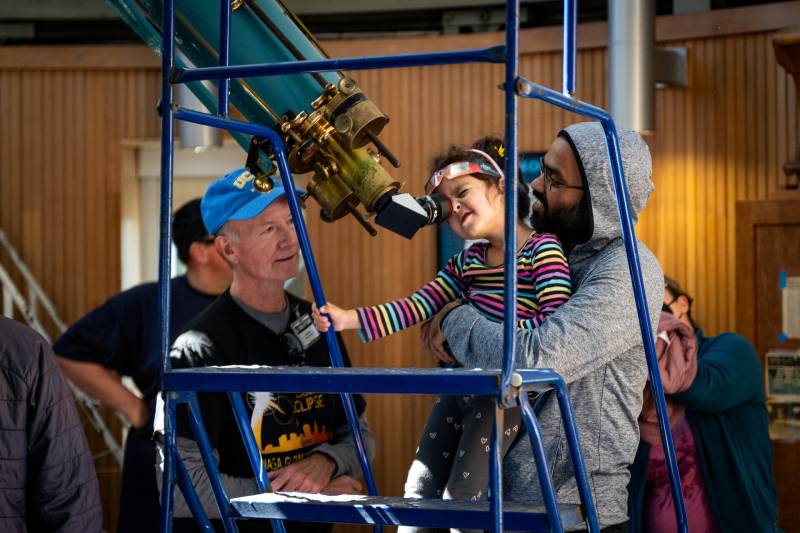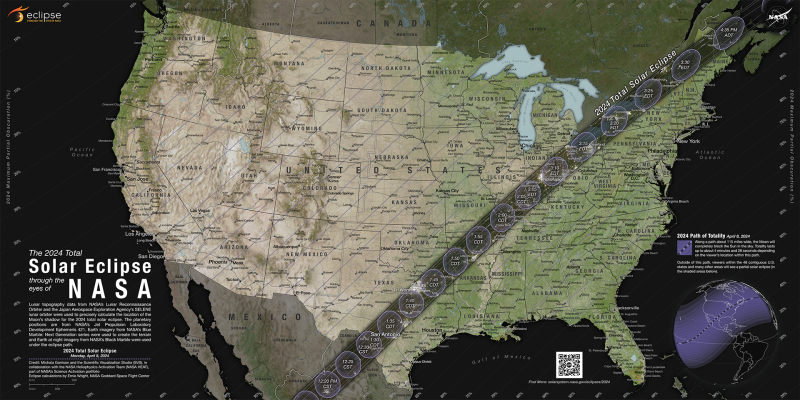Just after 10:30 a.m. Monday, the sky began to darken.
For those lucky enough to be in the narrow path for the first total solar eclipse over the U.S. in seven years, the sky filled with stars and planets as shadows sharpened all around.

Just after 10:30 a.m. Monday, the sky began to darken.
For those lucky enough to be in the narrow path for the first total solar eclipse over the U.S. in seven years, the sky filled with stars and planets as shadows sharpened all around.
But the Bay Area was still treated to a partial eclipse, and people came out in force, attending watch parties at Chabot Space and Science Center in the East Bay and Foothill Observatory in Los Altos and many other places.
“Today there’s not a cloud in the sky,” said astronomer Ben Burress, at the Chabot Space and Science Center. “This is a perfect day to watch an eclipse.”
Burress said he looked around for the subtle effects, like the slight dimming of the sunlight and for little crescents in the shadows of trees and bushes. “Some people [held up] a cooking colander, which has lots of holes in it, and casts its shadow on the ground,” he said. “You see lots of little crescents.”

The total eclipse was partially visible in Oakland, California from around 10 a.m. to noon. With their eclipse glasses on, the observers could stare directly at the crescent-shaped sun as the moon glided across.
“I have always wanted to see the solar eclipse,” said 15-year-old Loreila Simpson from Lincoln Middle School in Alameda, excitedly. “I’ve heard of it. And I’ve seen movies and read some stuff about the moon and the sun. I’m more of a lunar person. To see the moon just take over the day for a while is so funny to me.”
Chabot has two historic telescopes — both about 100 years old, explained Jared Wilson, a volunteer helping with the viewing party at Chabot. This includes one of the largest telescopes available to the public for general viewing.
“We will see part of the eclipse. We’re not in the path of totality. So the moon will not cover the sun completely from the Bay area,” Wilson said. “We will get to see the moon passing partially in front of the sun.”
For Carolyn Whittle, who is 79 and lives in Oakland, she felt it was her last chance. “This is the last time it will cross the U.S. in totality before 2045,” Whittle said. “I won’t be here for the next eclipse, so I wanted to see this one.”
Members of the Peninsula Astronomical Society passed out viewing glasses to people gathered at Foothill Observatory in Los Altos Hills.
Folks from all over the South Bay formed a line to view the celestial event through a telescope
NASA astronaut Yvonne Cagle was on hand. She said the event helps people look up and out of their own daily concerns, and to see the bigger picture of our universe.
“When you look back at Earth from space, there are no borders,” she said. “And so it’s so wonderful to have everyone looking up in unison in unity. There’s nothing like space on Earth, that’s why we’re here.”
She said it was a special experience. “Not only is it special to me, but when I think that at this time in place, people from all over the world are all looking up at the same time. I think [it] says so much for our planet and our species.”
While the Bay Area saw about 35% coverage, other locations across the country experienced a total eclipse. “The eclipse is happening in a place where a large percentage of the American population saw it. The path of totality covers much of the United States,” Wilson said.
These unforgettable astronomical events occur when the moon positions itself between Earth and the sun, blocking the sun’s disc for a few minutes and creating a shadow on Earth known as the “path of totality.” The last time we had a total solar eclipse over the U.S. was in 2017.
And on Monday, those lucky enough to be in the path of totality with cooperating weather witnessed a breathtaking spectacle as the sun’s outer atmosphere (its corona) emerged like a crown of fire around the moon’s dark disc.
NASA said that the first place in continental North America to experience totality was Mexico’s Pacific coast. The eclipse traveled a narrow track of about 100 miles wide (but 10,000 miles long) that crossed three Mexican states, 15 U.S. states and five Canadian provinces.

What’s unique about the 2024 eclipse is that it was the longest and most visible for the U.S. in a century.
To learn more about how we use your information, please read our privacy policy.